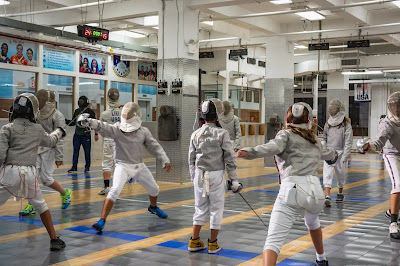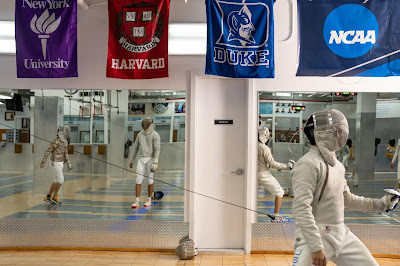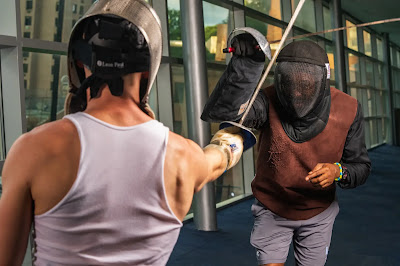Fencing Can Be Six-Figure Expensive, but It Wins in College Admissions
How niche sports offer a pathway to the Ivy League and other elite schools.
At the Manhattan Fencing Center, the athletes don’t look much like the swashbuckling heroes in the movies. There are no daring leaps or flips, no slashing or gallivanting around the room. Instead, young fencers methodically attack and parry along a long, narrow strip of floor. A hit — the touch of an opponent’s garb — can be missed by the naked eye.
But for families who invest in this expensive sport, the main target is quite clear — just look up. Hanging from the ceiling are flags from Duke, Harvard, N.Y.U., Johns Hopkins, Notre Dame, Princeton and Columbia, representing the clique of colleges and universities with N.C.A.A. fencing teams.
A way with a sword can help students stand out in the college admissions game, according to Yury Gelman, founder of the Manhattan Fencing Center.
“Parents,” he said, “realize that fencing is one of the best sports to put your child in a good university, because each good school, especially Ivy League schools, have fencing.”
Fencing is also expensive. Beyond coaching, equipment and club fees, fencers must often travel like a tennis pro to compete in the top tournaments — Bucharest, Cairo, Istanbul. Parents, for the most part, foot the bill, which can reach tens of thousands of dollars a year.
Those numbers place fencing — along with crew, golf, sailing, skiing and squash — squarely in the category of what are called “country club sports,” rarely played outside of predominantly white suburbs.
Fencing, along with these other sports, may get another hard look, as the Supreme Court prepares to hear two affirmative action cases against Harvard and the University of North Carolina, both to be heard on Oct. 31. The lawsuits, filed by Students for Fair Admissions, could well determine whether colleges can consider race in admissions in an effort to balance their classes.
If the court moves to prohibit or limit affirmative action, as widely expected, colleges likely will be under pressure to overhaul their entire admissions process — including practices that favor privileged applicants, according to Justin Driver, a Yale Law School professor.
“Preferences for athletes in niche sports would seem to be one of the first items on the chopping block,” said Mr. Driver, an expert on the court’s education decisions. Other categories include children of alumni, employees and donors.
Yet efforts to roll back these sports are likely to prompt a pushback, both from students who compete in them — many are also attractive to colleges because they require no financial aid — and alumni donors with fond memories of their playing days.
Partly because of the expense, fencing remains small compared with many other youth sports, but it has grown, especially as college admissions has become more selective. USA Fencing, the sport’s official national governing body, says that it had only 50 members under the age of 15 in the 1980s. Today there are more than 15,000, and the number of fencing clubs exceeds 700.
Colleges have defended fencing and other athletic programs as adding to campus life, building character and cementing alumni bonds.
“Athletics at Harvard builds community through the engagement of students, faculty, staff and alumni,” said Rachael Dane, a Harvard spokeswoman. “Harvard athletes are admitted through the same process, receive the same academic support, and are held to the same standards as every other Harvard student.”
And in recent statements and publications, Harvard has emphasized the growing economic and racial diversity of its classes.
But its admissions numbers, disclosed in the court case, reveal just how much niche sports and other special circumstances favor the affluent. Harvard admits fewer than 5 percent of applicants, and even those with top academic scores in the admissions office’s rating system have a hard time getting in. But among those top-scoring candidates, recruited athletes had an acceptance rate of 83 percent, compared to 16 percent of other students with similar scores, according to one internal university report, disclosed by the Harvard Crimson in 2018.
Another study, prepared by a Duke economist who served as an expert witness for Students for Fair Admissions, found that 43 percent of white students admitted to Harvard are either legacies, the children of Harvard faculty and staff members, recruited athletes, or those on a “dean’s interest list,” which generally includes big donors.
Harvard has only 30 students on its men’s and women’s fencing teams — too few to appreciably affect overall admissions breakdowns.
But its 42 different varsity teams include a complete roster of “country club sports.” In some years, 10 percent of Harvard’s admitted class is made up of athletes.
Kirsten Hextrum, a professor at Oregon State University who wrote a book, “Special Admission,” on athlete preferences, argues that niche sports play a role in perpetuating inequality.
“Even if it’s happening in a somewhat small number of elite schools and only for a small number of applicants,” Dr. Hextrum said, “those spots are so culturally and socially valued and coveted that it has a very broad impact.”
An Elite Pipeline
The sport gained a toehold in the United States as early as the 1750s, when a fencing school was operating near Wall Street. Harvard started fencing as a club sport in 1889 and, soon after, began competitive bouts with other Ivy League schools.
But fencing never achieved mass appeal. More than a century later, only 44 out of 1,100 N.C.A.A. schools have teams. Sixteen of them are fielded by highly selective colleges with admissions rates of 16 percent or lower, according to an analysis by the website fencingparents.org, a guide for parents seeking college admission through fencing.
The schools are heavily concentrated in the eastern United States, with a few exceptions like Stanford and the University of California, San Diego.
For child fencers aspiring to attend highly selective colleges, the journey frequently begins at one of about 30 clubs that regularly turn out college-bound athletes. The Manhattan Fencing Center, located in an expansive space on the second floor of an office building in Midtown, is one of the most successful.
This year, the center lists 11 college freshmen it claims as success stories.
A star is Matthew Linsky, who won a gold medal in January in a competition in Bucharest, Romania, placing him near the very top of international saber fencing.
Mr. Linsky is ranked 13th among young saber fencers, leading to his recruitment by Harvard, Yale, Penn and Duke, according to his mother. He arrived on Harvard’s campus this fall, one of 1,646 new freshmen from more than 60,000 applicants.
A graduate of the High School for Math, Science and Engineering, a competitive public school in Manhattan, Mr. Linsky says he enjoys the mental side of the sport as well as the whirlwind of international competition. He says fencing also builds agility, speed and coordination.
His mother, Irene Linsky, who works in information technology for a major bank, recounts a less glamorous side, working remotely from hotel rooms in cities around the world.
To help pay for his training, Matthew received financial assistance from a small charitable foundation Mr. Gelman sponsors. Ms. Linsky, a single mother, said she has been grateful for the help, adding, “It’s still expensive. Don’t get me wrong.”
A 20-minute lesson can run $50; fencers pay membership fees; good equipment costs $1,500 to $2,000, and must be replaced frequently. The main cost, though, is travel. Parents frequently accompany their children and foot the bill for the coaches.
“We did a calculation about five years ago,” Mr. Gelman said. “Parents were spending close to $40,000 a year.”
Donna Meyer, a former investment banker and fencing mother who runs the parents website, said she knows one couple who spent $100,000 a year.
“Not every parent is wealthy, but they will stretch because they see it as worthwhile — this paves the way for my child to get into an elite college,” she said.
Another Manhattan Fencing star, Elizabeth Tartakovsky, a senior at Harvard who holds the N.C.A.A. title in women’s saber fencing, said she is grateful for the sacrifice by her parents, executives in the pharmaceutical and banking industries.
Fencing has had its own bribery scandal, similar to Operation Varsity Blues, a scheme to influence college admissions that ensnared more than 50 people, including actors Lori Loughlin and Felicity Huffman.
In 2019, Peter Brand, the coach of Harvard’s fencing team, was fired after a university investigation. He now stands accused of accepting $1.5 million in bribes to recruit the sons of Jie Zhao, a business executive who lives in Maryland. Both men have pleaded not guilty and face trial in December.
Aware of the sport’s cost and elitist reputation, USA Fencing is moving to broaden its reach, said Bryan Wendell, a spokesman for the organization.
The group recently hired a senior manager for diversity, equity, inclusion and belonging.
“We want there to be Olympians who come from nontraditional fencing areas,” he said.
In New York, Peter Westbrook, an Olympic medalist in fencing, started a foundation to help potential fencers from different racial and economic backgrounds. Among the beneficiaries was Ivan Lee, who ultimately became a two-time national champion and is currently the fencing coach at Long Island University.
“Peter had that vision where he wanted to spread the sport of fencing to children in the inner city,” said Mr. Lee, who grew up in Brooklyn and went to St. John’s University. Mr. Lee, 41, says that, even two decades ago, his parents saw fencing as a pathway to college.
Can Fencing Keep Its Advantage?
Eileen Ye, who attended the private Brearley School and trained at Manhattan Fencing Center, is attending Harvard this fall, without being a recruited athlete.
Even so, she said, “I definitely think fencing added to my application.”
Ms. Ye was good enough to make the women’s team, one of 15 students on the roster, just as fencing and other elite sports are under a microscope.
Then again, the tradition of athletic preferences could be hard to extinguish.
Two years ago, faced with financial strains from the pandemic, Stanford decided to eliminate fencing and 10 other sports — men’s rowing, sailing, squash and synchronized swimming —because of their high costs.
Following a backlash from alumni, they were reinstated.









No comments:
Post a Comment